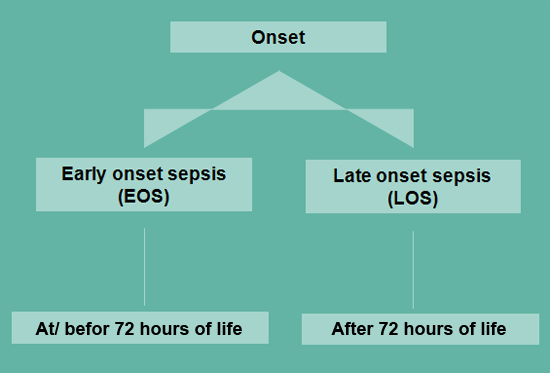Sources of systemic infection
- Introduction...
- 1. Types of neonat...
- 2. Pathogenesis of...
- 3. Maternal risk f...
- 4. Risk factors of...
- 6. Risk factors of...
- 7. In developing c...
- 8. Preventive stra...
- 9. Key messages...
 |
 |
Introduction
DR. RAMESH AGARWAL
MD, DM (Neonatology)
Professor
Department of Pediatrics
All India Institute of Medical Sciences
New Delhi
1. Types of neonatal sepsis

2. Pathogenesis of EOS

3. Maternal risk factors for EOS
► Rupture of membrane >24 hours
► Spontaneous preterm labor
► Chorioamnionitis
♦ Maternal fever (>100.4°F) and
♦ Two of: maternal tachycardia, fetal
tachycardia, foul smelling liquor, uterine
tenderness, maternal leukocytosis
(>15,000 cells/mm3)
► Prolonged labor (>24h)
► Unclean or multiple PV examination
► Maternal UTI or diarrhea
4. Risk factors of LOS in hospitalized neonates
(Healthcare associated infections; HAI)
► Lack of adequate hand hygiene
► Procedures and investigations
► Suboptimal asepsis routines
► Infection occurring during ventilation particularly during
ET suction
► Overcrowding in the unit and low nurse-patient ratio
► Lack of breastmilk feeding
► Use of IV fluids, unnecessary drugs and antibiotics

6. Risk factors of LOS in neonates in the community
(Community acquired infections; CAI)
► Contaminated environment
► Lack of hygiene practices
► Superficial infections such as umbilical sepsis and many
pustules
► Lack of breastfeeding

7. In developing countries
(EOS in hospitalized neonates is like LOS)
► Perhaps due to
♦ Horizontal transmission due to unhygienic practices
during birth, resuscitation and first few hours
♦ Colonization of maternal genital tract with resistant
pathogens
8. Preventive strategies
► Early onset sepsis
♦ Must be directed towards preventing maternal risk factors
♦ Hygienic birthing and resuscitation and early care giving
practices
► Late onset sepsis
♦ Good NICU practices in hospitals
♦ Hygienic practices in homes
♦ Breast milk feeding
9. Key messages
► Source of infection
♦ Early onset sepsis: maternal genital tract
(vertical transmission)
♦ Late onset sepsis: environment, suboptimal care giving
practices (horizontal transmission)
► Prevention of sepsis therefore must be directed towards
risk factors of respective type of sepsis
